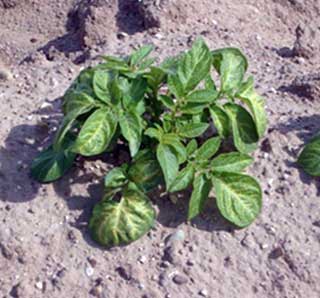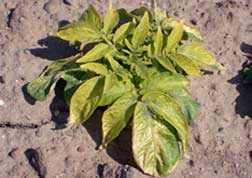Herbicide sensitivity in potatoes
Editor’s note: This article is from the archives of the MSU Crop Advisory Team Alerts. Check the label of any pesticide referenced to ensure your use is included.
Potatoes have a wide variation in growth habit and response to environment, particularly due to genetic variation which can be attributed to its polyploidy nature. It is therefore no surprise to those who grow potatoes that varieties respond differently to herbicide applications. Herbicide options for weed control in potatoes are limited to several compounds that have been around for decades with a few newer ones mixed in. Herbicide injury in potato varieties with Sencor is well documented and is taken into consideration when planning Sencor use for weed control. The cool weather this spring has created conditions that favor the enhancement of herbicide injury in crops. Cool weather slows the metabolism of herbicides in the crop, which allows the herbicides to block pathways and induce injury not normally observed in potatoes. Coupled with the inherent sensitivity of some varieties, severe injury can occur.
Potato varieties, such as Atlantic or the newer Silverton Russet, grown in Michigan that show varietal sensitivity to herbicides on a normal year, may show greater injury when the weather has slowed potato growth. Potatoes are commonly sensitive to Sencor/Lexone (metribuzin), however, herbicides that potatoes are not generally sensitive to, including Dual Magnum /Cinch/Parallel/Stalwart (metolachlor), Outlook (dimethenamid-p), Lorox (linuron) and Matrix (rimsulfuron) can cause injury under adverse conditions, such as cool, wet weather, when soil applied. Injury can also be observed after herbicide application in hot, humid weather. It is important to time herbicide applications to avoid coinciding with stress-inducing conditions to help avoid injury. Some herbicides such as EPTC can cause wrinkled leaves and other injury if applied at a rate exceeding label recommendations. Drift is also a concern during the growing season with glyphosate and phenoxy herbicides, such as 2 4-D, causing injury to emerged plants.
This spring injury due to the cool weather has been observed after Sencor and Lorox applications. Injury symptoms for Sencor (Figure 1) include interveinal whitening and yellowing of the leaf, generally most evident on the older leaves. Similar injury symptoms occur with Lorox (Figure 2), however whitening and chlorosis often occurs on the leaf margin. Many nutrient deficiencies and environmental stress responses can resemble herbicide injury, therefore if you suspect you have herbicide injury, contact your local Extension educator to help diagnose symptoms accurately.
Herbicide rates and recommendations for weed control in potatoes can be found on pages 118 to 123 with weed and crop response ratings on page 125 in 2008 Weed Control Guide for Field Crops.
 |
 |
Figure 1. Sencor injury on potato.
|
Figure 2. Lorox injury on potato.
|



 Print
Print Email
Email


